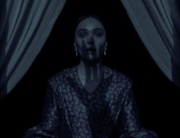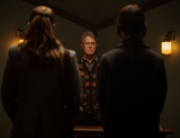Directed by Pedro Almodóvar
Produced by Agustin Almodóvar & Esther García
Written by Pedro Almodóvar & Agustin Almodovar, based on the novel Mygale by Thierry Jonquet
Released by Sony Pictures Classics
Spanish with English subtitles
Spain. 115 min. Rated R
With Antonio Banderas, Elena Anaya, Marisa Paredes & Jan Cornet
In his stylish psychological thriller-cum-horror film The Skin I Live In—which omits any shred of credible psychology—Pedro Almodóvar introduces his mad scientist, Robert Ledgard, as a plastic surgeon who’s invented a new skin impermeable to burns or disease. The film begins forebodingly with the doctor telling stunned colleagues about his discovery, insisting that he hasn’t been experimenting on humans. We know better, of course. Back at his home, a gorgeous prison-like mansion, is guinea pig Vera, a beautiful young woman locked in a large, sound-proof room. Her connection to the outside world consists of meals and books sent
via dumbwaiter by Robert’s faithful, long-suffering servant Marilia, who along with Robert spies on Vera thanks to close-circuit cameras and monitors (including a life-size one, which makes it seem as if Robert watches Vera on a movie screen, a typical Almodóvar trope). Just who is Vera, and why has she submitted to the brilliant doctor, who still grieves for the loss of his wife in a horrific car accident 12 years before? And what secret does Marilia, who carries out Robert’s bidding unquestioningly, hide?
Almodóvar eventually explains everything over the course of two wearying hours, but it’s impossible to discuss the specifics of the increasingly bizarre plot and characters without spoiling it for viewers. Suffice it to say that Robert’s skin experiment is only the tip of a very convoluted iceberg that includes a revenge vaginoplasty (there’s a phrase I never thought I’d write).
Appreciating the freak show that is The Skin I Live In depends on the viewer’s tolerance for coincidence and belabored plot twists, like the sudden appearance of Marilia’s criminal son, Zeca, in a clownish disguise at Robert’s home (conveniently when the doctor is away). Aside from explaining the connection between Zeca, Robert, and Robert’s dead wife (whom Vera resembles, we also discover), the sequence is also important for moving the plot both forward and backward. It’s the trigger for several flashbacks that fill out the back stories of the characters and their relationships with one another, including Robert and Vera‘s improbable physical and emotional closeness.
There is an undeniable artfulness to Almodóvar’s clever structure. By the time the movie’s final half-hour rolls around and it’s explained who Vera really is, it’s too late to object to some pretty blatant holes in both plot and characterization. Then there’s the ending, a deviously devised but unsatisfying attempt to pull one last rug out from under viewers. The movie’s frenzied atmosphere is echoed in Alberto Iglesias’ alternatingly haunting and heaving musical score, José Luis Alcaine’s opulent photography, José Salcedo’s showy editing, and, most of all, Antxon Gómez’s baroque art direction. Robert’s home is filled with artworks, featuring a wall-size copy of Titian’s masterpiece Venus of Urbino (the real painting is in Florence’s Uffizi gallery), which Almodóvar later parallels with a striking shot of a reclining Vera. Such overwhelming artifice, both visually and aurally, threatens to capsize Almodóvar’s slender melodrama.
Antonio Banderas suffers nobly as Robert, while Elena Anaya has little to do except look fabulous as Vera. The actress is reminiscent of another gorgeous Almodóvar femme fatale from his early years, Victoria Abril, who was more feminine than the boyish-looking Anaya (for this movie, that’s an important distinction). It’s worth noting that Banderas starred with Abril in Tie Me Up! Tie Me Down!, the film which introduced the pair to international audiences. As Marilia, the reliable Marisa Parades is yet another link to Almodóvar’s past glories.
It’s almost impossible to square the director of The Skin I Live In and other slick comedy-dramas like Broken Embraces, Volver, and Talk to Her with such delightfully ramshackle mid-’80s efforts as Matador, Law of Desire, and Dark Habits. Although the more recent
films are quality examples of dazzling craft, I prefer, like the aliens in Woody Allen’s Stardust Memories, “the early, funny ones.”
















Leave A Comment